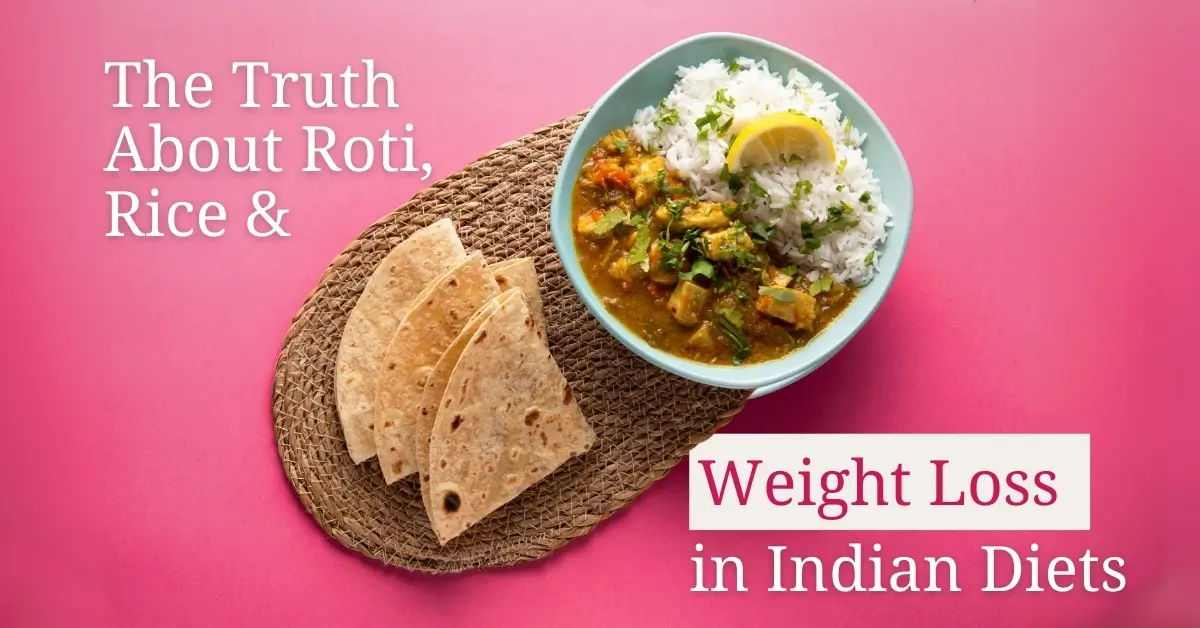“Should I stop eating rice?”
“Is roti better for weight loss?”
These are some of the most common questions Indian clients ask when starting their fat-loss journey.
Let’s bust the myths and understand the real truth behind roti, rice, and weight loss—without giving up the Indian foods you love.
🧠 Why This Debate Even Exists
Both roti and rice are carbohydrates, and carbs often get blamed for weight gain. But not all carbs are bad. In fact, your body needs carbs for energy—especially complex ones that come from whole foods like roti and rice.
The key is to understand:
- What type of carbs you’re eating
- How much you’re eating
- What you’re eating them with
🍞 Roti: Pros and Cons for Weight Loss
✅ Why Roti Can Help With Weight Loss
- Made from whole wheat, jowar, or bajra (complex carbs)
- Higher in fiber than rice
- Keeps you fuller for longer
- Easy to portion (1-2 per meal)
❌ When Roti Becomes a Problem
- Overeating (3-4+ per meal)
- Adding ghee or butter regularly
- Eating with heavy curries or fried sabzis
Best Practice: Stick to 1-2 medium rotis made from whole grains. Avoid adding ghee if you’re watching calories.
🍚 Rice: Is It Really the Enemy?
✅ When Rice is Okay for Weight Loss
- Easy to digest and good for gut health
- Can be part of a balanced lunch
- Brown or hand-pounded rice is higher in fiber
- Great for post-workout meals due to fast energy release
❌ When Rice Causes Weight Gain
- Eating large portions (2+ cups)
- Pairing it with fried, oily curries
- Eating it for dinner and sleeping right after
Best Practice: Eat 1 cup of cooked rice (preferably at lunch), and pair with dal, sabzi, or curd.
🥗 How to Choose Between Roti or Rice for Weight Loss
There’s no one-size-fits-all answer. Both rice and roti can fit into a healthy Indian diet. The smarter approach is customization based on your body and lifestyle.
| Food | Calories | Fiber | Digestibility | Satiety |
| Roti (Whole Wheat) | ~80 per roti | High | Medium | High |
| Jowar/Bajra Roti | ~100 | Very High | Medium | Very High |
| White Rice (1 cup) | ~130 | Low | High | Medium |
| Brown Rice (1 cup) | ~110 | High | Medium | High |
🧘♀️ When to Choose Roti:
- You need a more filling meal
- You have blood sugar concerns (lower glycemic index)
- You prefer variety (can use bajra, jowar, multigrain)
🕒 When to Choose Rice:
- You’re short on time and need easy digestion
- Post-workout or high-activity days
- You’re eating lunch and want to pair it with dal or sabzi
🛑 What Actually Causes Weight Gain
It’s not roti or rice—it’s:
- Overeating overall calories
- Too little physical activity
- High intake of fried, processed, or sugary foods
- Skipping meals then binge-eating later
- Eating late at night
🔄 Balanced Plate = Fat Loss
Whether you choose roti or rice, always make sure your plate includes: ✅ Protein (dal, paneer, eggs, curd)
✅ Fiber (salad, sabzi, sprouts)
✅ Healthy fat (1 tsp ghee, seeds, or nuts)
✅ Limited carbs (2 rotis or 1 cup rice—not both!)
✅ Final Thoughts
You don’t need to quit rice or roti to lose weight. The real success lies in portion control, food pairing, and timing. A balanced Indian diet can absolutely help you shed fat—while still eating the foods you love.
🔗 Still confused about what suits your body best?
Let Pallavi Q Slim Fitness help you build the perfect Indian weight loss meal plan!


